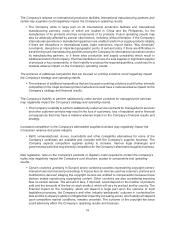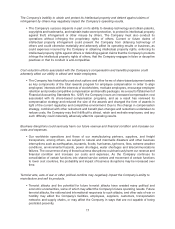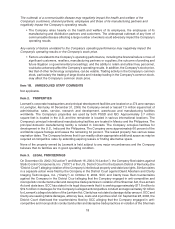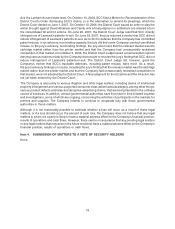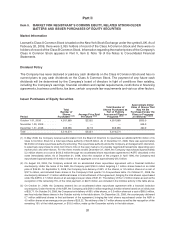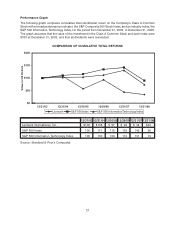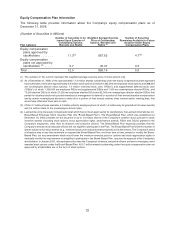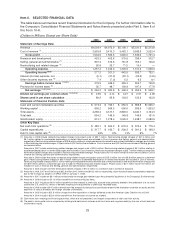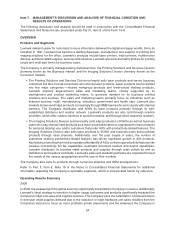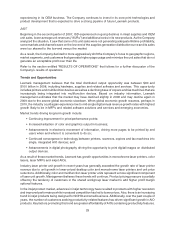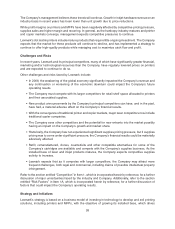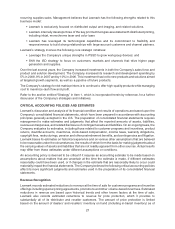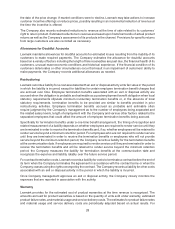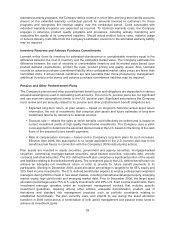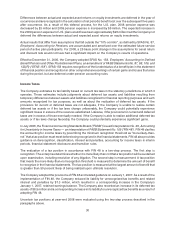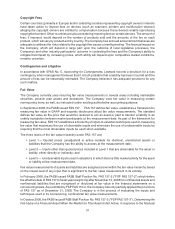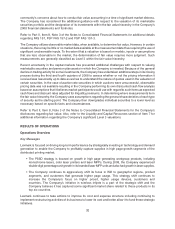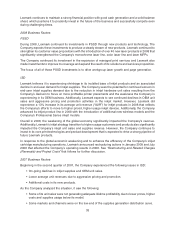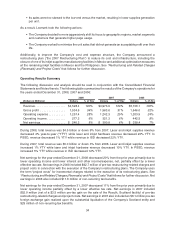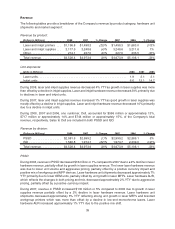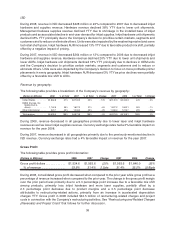Lexmark 2008 Annual Report Download - page 32
Download and view the complete annual report
Please find page 32 of the 2008 Lexmark annual report below. You can navigate through the pages in the report by either clicking on the pages listed below, or by using the keyword search tool below to find specific information within the annual report.The Company’s management believes these trends will continue. Growth in inkjet hardware revenue on an
industry basis in recent years has been lower than unit growth due to price reductions.
While profit margins on printers and MFPs have been negatively affected by competitive pricing pressure,
supplies sales are higher margin and recurring. In general, as the hardcopy industry matures and printer
and copier markets converge, management expects competitive pressures to continue.
Lexmark’s dot matrix printers include mature products that require little ongoing investment. The Company
expects that the market for these products will continue to decline, and has implemented a strategy to
continue to offer high-quality products while managing cost to maximize cash flow and profit.
Challenges and Risks
In recent years, Lexmark and its principal competitors, many of which have significantly greater financial,
marketing and/or technological resources than the Company, have regularly lowered prices on printers
and are expected to continue to do so.
Other challenges and risks faced by Lexmark include:
• In 2008, the weakening of the global economy significantly impacted the Company’s revenue and
any continuation or worsening of the economic downturn could impact the Company’s future
operating results.
• The Company must compete with its larger competitors for retail shelf space allocated to printers
and their associated supplies.
• New product announcements by the Company’s principal competitors can have, and in the past,
have had, a material adverse effect on the Company’s financial results.
• With the convergence of traditional printer and copier markets, major laser competitors now include
traditional copier companies.
• The Company sees other competitors and the potential for new entrants into the market possibly
having an impact on the Company’s growth and market share.
• Historically, the Company has not experienced significant supplies pricing pressure, but if supplies
pricing was to come under significant pressure, the Company’s financial results could be materially
adversely affected.
• Refill, remanufactured, clones, counterfeits and other compatible alternatives for some of the
Company’s cartridges are available and compete with the Company’s supplies business. As the
installed base of laser and inkjet products matures, the Company expects competitive supplies
activity to increase.
• Lexmark expects that as it competes with larger competitors, the Company may attract more
frequent challenges, both legal and commercial, including claims of possible intellectual property
infringement.
Refer to the section entitled “Competition” in Item 1, which is incorporated herein by reference, for a further
discussion of major uncertainties faced by the industry and Company. Additionally, refer to the section
entitled “Risk Factors” in Item 1A, which is incorporated herein by reference, for a further discussion of
factors that could impact the Company’s operating results.
Strategy and Initiatives
Lexmark’s strategy is based on a business model of investing in technology to develop and sell printing
solutions, including printers and MFPs, with the objective of growing its installed base, which drives
26


